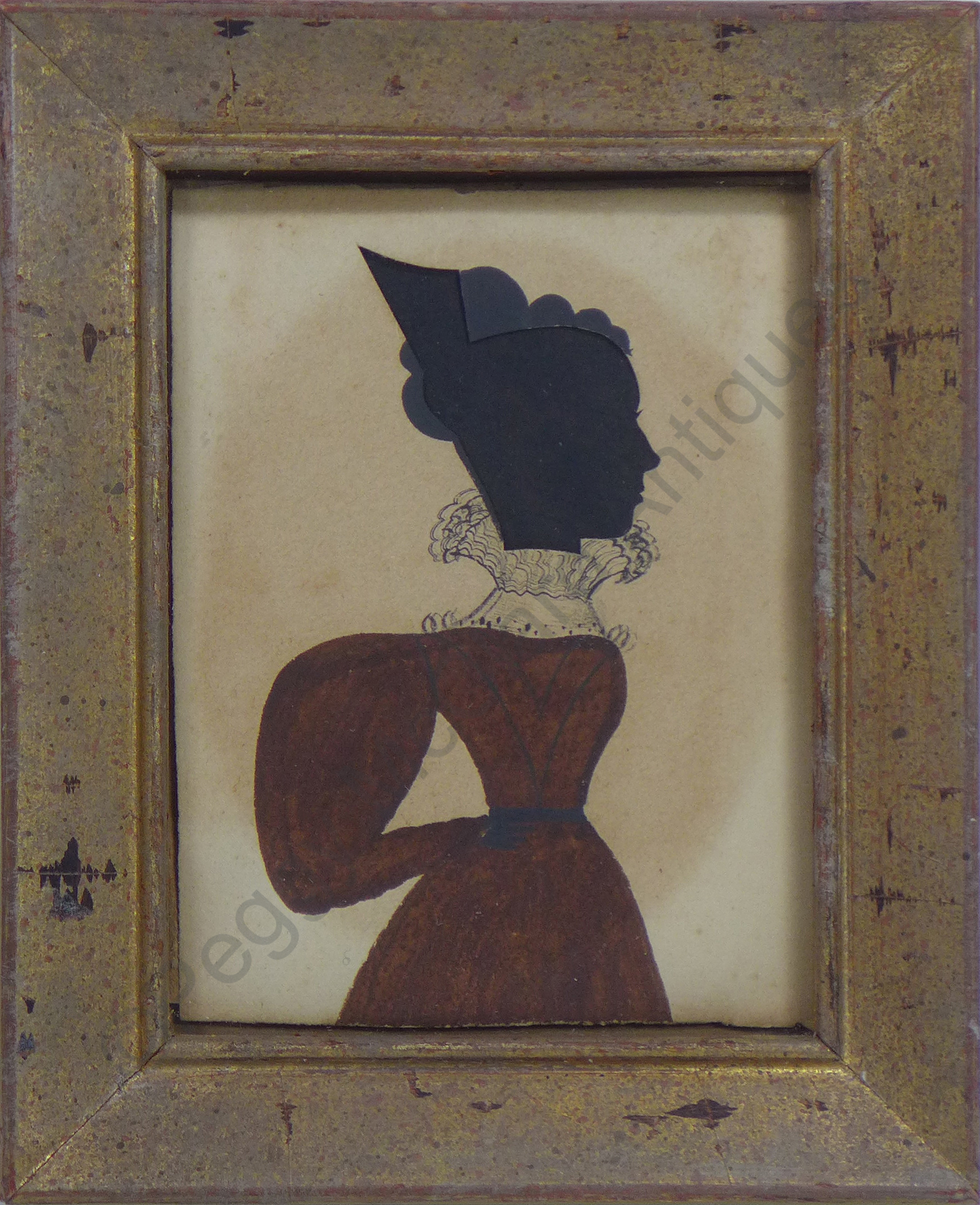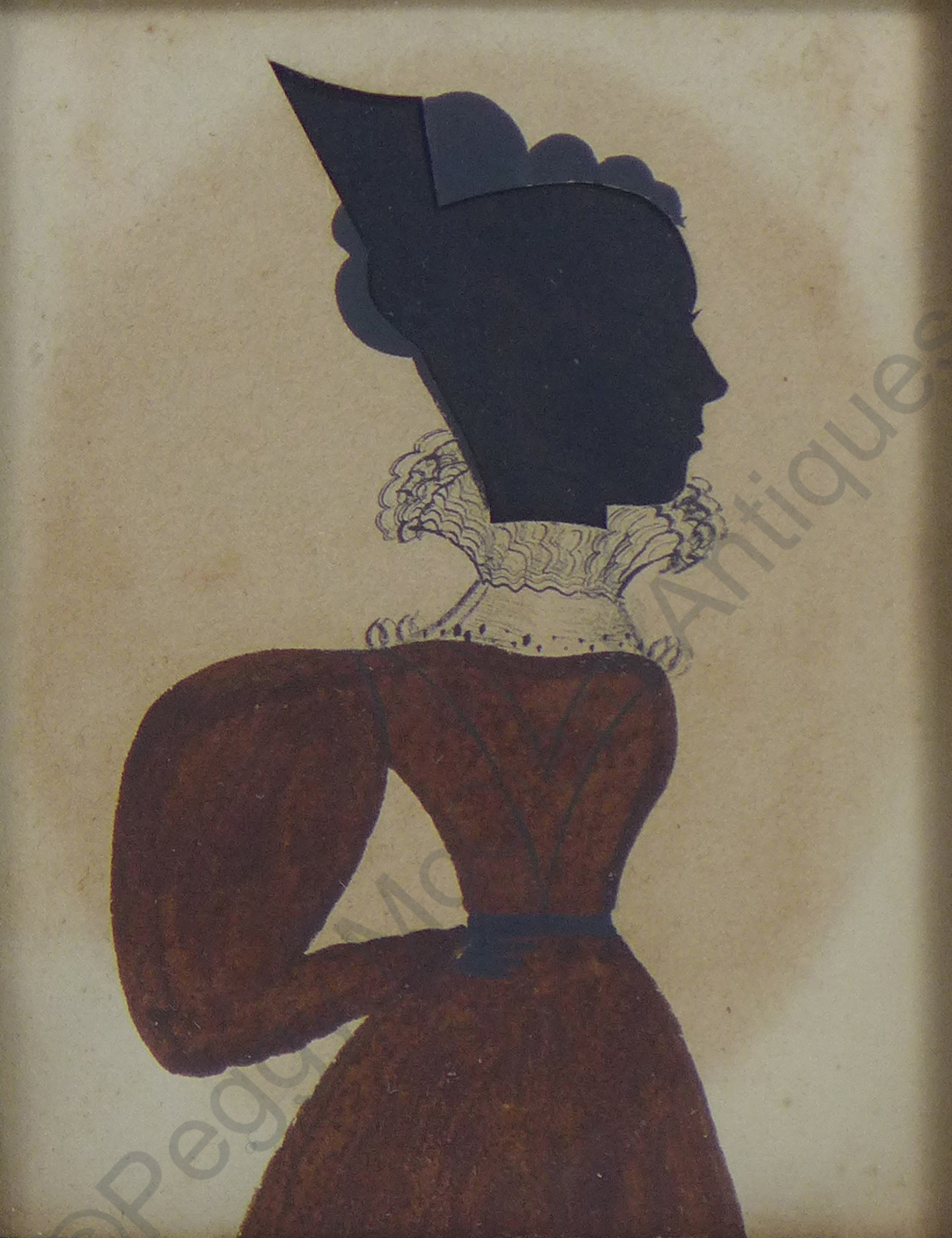
This fabulous American folk silhouette is attributed to the Puffy Sleeve Artist. This artist left behind a wonderful legacy of unique naïve silhouettes with hollow cut heads atop watercolor bodies. The profiles are all three-quarter length with women always facing right and men always facing left. In the last decade some full-bodied children have been found and attributed to the same artist—the jury is still out in my mind as to whether the children are by The Puffy Sleeve. With regard to those silhouettes that have long been attributed to this highly collected artist (i.e. the adult women and men), the hollow-cut heads of women sit high above their bodies with long necks that give room to highlight their necklaces and fichus. The women's hair combs are hollow cut and sit high above their head. Hair is added above the head as rolls leading to the final Apollo knot held by the cut hair comb. The hair is painted dark black with India ink or watercolor. The dresses are always painted, usually blue or black. The right hands of the women rest at waist length and the left hands sometimes hold an accessory such as a book, purse, parasol, or flower. Books often bear the initials or age of the sitter and a date. Like the women, men have their hair painted around the hollow-cut head. The left hand is frequently in the man's pocket or resting at hip length. The right hands of the men generally hold a decorative object such as a hat, book, cane or even a trumpet. Hands of both women and men appear to be gloved in either white or black. The hands that hold books tend to be painted almost as a claw where one can only see the thumb and small finger with the book held between. Where the sitter holds a more vertical object, the forefinger seems to point outward while the other fingers bend to clasp the object. Many of these silhouettes have been found in gilded frames with an inset rope, leading some to believe that these were the only original frames used by this artist. I believe that enough have been found in originally sized period frames that this artist may have used many different frames. Itinerant artists often bought frames from different frame-makers as they worked their way along their routes. All recorded dated examples bear the dates of 1830 or 1831.
In 1942, Olive Crittenden Robinson published an article about silhouettist and wood turner Ezra Wood that suggested that Ezra Wood might be The Puffy Sleeve Artist. Ms. Robinson, however, was not convinced that the unsigned boldly “folk” silhouettes attributed to The Puffy Sleeve Artist were cut by the same artist as those known to be by Ezra Wood. In 2014, a second article argued that The Puffy Sleeve was Ezra Wood. See Payne, Suzanne Rudnick, Michael Payne & Samuel Herrup, “Unmistaken identity”, Magazine Antiques, Jul/Aug2014, Vol. 181 Issue 4, 122. Ezra Wood (1798-1841) was born with his twin, Joel, in Buckland, Massachusetts to John and Susannah (Wood) Temple. Unlike many silhouettists who added silhouette cutting to their repertoire of painting portraits, Wood seems to have only worked with the artforms of silhouette cutting and wood turning. His woodshop was known for turned shaving boxes, hair combs and hair crimpers. Also unlike so many silhouettists of the 19th century, Wood seems to have practiced his art at home instead of as an itinerant. Wood’s brother-in-law owned a tavern that was across the street from his home and there was another tavern close-by. Wood, who had a license to sell liquor, likely encountered many patrons of the taverns ready to pay to have their profiles cut.
It is noteworthy that many, if not most, of the silhouettes seen online as attributed to “The Puffy Sleeve Artist” are fakes, reproductions being sold as antique, and by artists who did similar work during the same time period. See for example the silhouette I am offering currently in the blue dress with the short puffed sleeve and bare arm. The style is extremely similar but when you look at the differences of the profile cutting and the delicate hair ornamentation of the blue dressed lady you can pick up the differences. I have three or four women who are from the same period but not by the same hand. I have two men also from the same period and similar styling but not the same hand. Everyone may collect whatever they like, but please be sure that you are getting what you think you are. Ask for authentication from an expert before you pay many thousands of dollars for work that is so often faked.
This is an authentic Puffy Sleeve Artist. It is from the esteemed folk art collection of Dr. Ralph & Ms. Suzanne Katz. She wears an unusual deep red dress with a black belt and gloves. The dress bodice is pleated in the shape of two “V”s which stop just above the waist. Her ruffed collar is delicately depicted with squiggly lines showing the lace framing the lady’s face. Below the collar a fichu of white lace covers her décolletage to the neckline of her dress. Her profile is beautifully cut with a slight upturn to her nose and a small delicate eyelash cut in just the right spot. (Quite often, the fake pieces have very square turn at the chin and the eyelash is poorly cut—look for such details in others that you see.) The hair comb is tall and sits at the crown of her head. The black painted hair is in rolls would have been tight curls framing her face with a knot at the top (aka Apollo knot). The paper has slight overall toning with a bit more pronounced toning in an oval that would have been the oval portal of an églomisé glass mat or a stamped brass over wood frame. The toning is darker in the photos than real life—those who know me know that I always accentuate condition issues in website photos so you can only be pleasantly surprised when the piece arrives. She resides in a handsome and appropriate reproduction frame that is gilded over what appears to be red and grey bole and aged to an appropriate period look. The framed size is 4 ½” x 5 ½”. Sight size is 3” x 4”. Circa 1830. A lovely and very desirable silhouette from an outstanding and recognized collection.
#5883 Sold
Provenance: Collection of Ralph & Suzanne Katz
References:
Anderson, Marna, A Loving Likeness American Folk Portraits of the Nineteenth Century, Bristol-Myers Squibb Co. (1992), 44-47.
Payne, Suzanne Rudnick, Michael Payne & Samuel Herrup, “Unmistaken identity”, Magazine Antiques, Jul/Aug 2014, Vol. 181 Issue 4, 122.
Robinson, Olive Crittenden, “Ezra Wood, profile cutter”, Magazine Antiques, August 1942.

